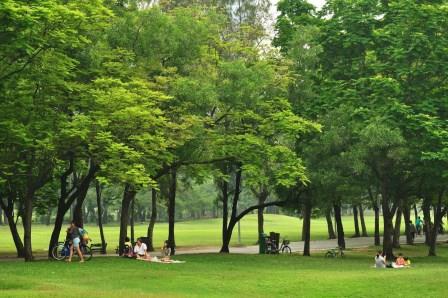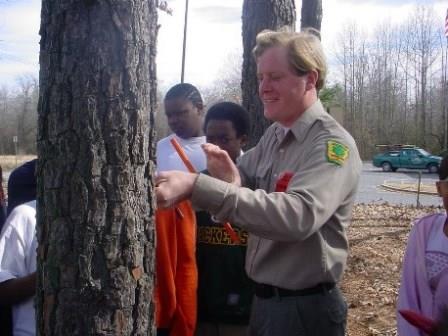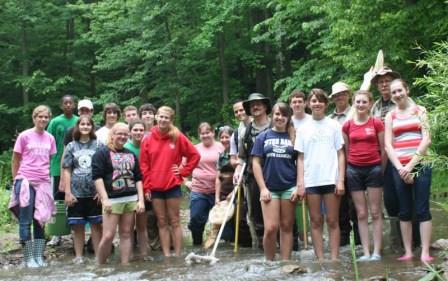 Trees clean our air and our water; they give us shade and more than 5,000 products that people use every day; they provide habitat for wildlife and make our world more beautiful.
Trees clean our air and our water; they give us shade and more than 5,000 products that people use every day; they provide habitat for wildlife and make our world more beautiful.
To help high school students appreciate trees and forests, and learn about the value of trees in their community, try using Project Learning Tree’s Focus on Forests and Places We Live secondary modules together.
Here are two suggestions for ways to combine lessons from these modules that will spark discussions and higher level thinking about the benefits of trees and forests in the place you live – from aesthetic and health values, to economic and environmental benefits. The lessons will also help individuals understand how they might preserve and protect forests, and conserve green space in their own neighborhoods.
To get these PLT modules, contact your PLT State Coordinator about attending a workshop in your state. To access the Student Pages referenced below for each activity, login or create an account (it’s free!)
What’s the Value of Trees in Your Community?
Here are a few instructional ideas to help your students understand — and calculate — the value of trees in your community.
Ask students to think about the value of trees:
- Use the Tall Tree Tales Student Page included with Activity 5, Green Space in PLT’s Places We Live module. After students complete the worksheet, ask how many statements out of 20 they marked as true.
- Tell them that all of the statements about the benefits of trees are true.
- Discuss how they categorized the benefits of trees and point out that some statements may apply to more than one category, which helps to illustrate the multiple reasons forests, trees, and green spaces should be conserved in communities.
 Explain that various tools exist to assess and demonstrate the approximate dollar value of individual trees:
Explain that various tools exist to assess and demonstrate the approximate dollar value of individual trees:
- Spend time exploring the National Tree Benefit Calculator, and explain the various parameters it measures. The calculator allows anyone to make a simple estimation of the benefits individual trees provide.
- You can also challenge students to try the calculator using the trees on the one-tenth of an acre plot they set up as part of PLT’s Monitoring Forest Health activity. Students might assess the value of each individual tree—or estimate the value of the entire plot!
- Remember to provide students with tree identification guides, DBH tapes, and the Evaluating Tree Benefits Student Page included with Activity 1, Monitoring Forest Health in PLT’s Focus on Forests module to help them with the task at hand.
Debrief the activity by discussing the following questions:
- Were you surprised to find out the many benefits that the trees provided on this small plot of land?
- What other benefits do trees provide that were not included in the National Tree Benefits Calculator?
- Why is it important to manage and care for trees in your community?
- How can citizens improve the quality and quantity of trees in your community?
- How might we communicate to others about the true value of trees and forests and the benefits they provide?
Tough Choices in Your Community
 Try combining Activity 4, Tough Choices in PLT’s Focus on Forests module with Activity 2, Community Character in PLT’s Places We Live module and organize a mock town meeting to discuss a forest-related issue in your local community.
Try combining Activity 4, Tough Choices in PLT’s Focus on Forests module with Activity 2, Community Character in PLT’s Places We Live module and organize a mock town meeting to discuss a forest-related issue in your local community.
Students will investigate and defend a particular viewpoint as they take on the roles of environmentalists, scientists, local officials, business owners, and residents. They’ll discuss multiple perspectives and remember this engaging, problem-solving activity long after they graduate!
Explain that one way to better understand an environmental issue is to identify and analyze its components:
- Have students review the What Makes Up an Environmental Issue Student Page included with Activity 4, Tough Choices in PLT’s Focus on Forests module.
- Challenge students to brainstorm different land use issues in their community, for example, development of open space, construction of new roads, proposal for a new mall or big box store, creation of a mass transit system, habitat protection, or rezoning of an area.
- Have students vote on a single issue to analyze.
Assign small groups of students to pretend to be the various players in the community involved in making decisions about the topic:
- Use the Analyzing the Issue Student Page as a guide and, for each group’s assigned role, help students complete their “Positions,” “Values,” “Opinions,” and “Possible Solutions.”
- Prepare students to participate in a mock town meeting where this issue will be discussed. Students should attend the meeting prepared to speak on behalf of their assigned position and to present their solution to the issue. If time permits, students can conduct research and develop a PowerPoint presentation or other visuals to illustrate their position.
- Hold the mock town meeting with pre-selected and non-biased “city council member” volunteers. Give each student group an equal amount of time to present their position and proposed solution, and then have the city council meet privately, vote on the best solution, and finally announce (and explain) their decision to the class.
Debrief the activity by discussing the following questions:
- Do you personally agree with the city council’s decision? Why or why not?
- Do you agree with the criteria used by the city council to make their decision? Why or why not?
- Was a compromise achieved?
- How is (or isn’t) this process similar to what happens in real life?
- Why do you think cities and towns have zoning laws and land-use plans? What would happen if they didn’t?
Pulling it All Together
Review and assess what students learned by discussing how knowledge of the actual (monetary) value of trees and forests could be used in real town meetings to influence the outcome of proposed zoning changes and land-use plans— as well as to encourage that trees and green space be conserved in your area.
To get PLT’s Focus on Forests and Places We Live secondary modules, contact your PLT State Coordinator about attending a workshop in your state. To access the Student Pages for each activity, login or create an account (it’s free!)


